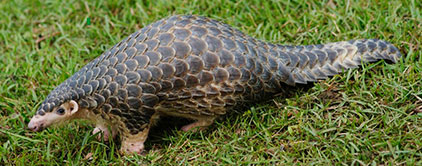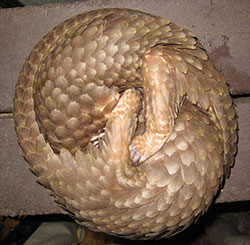Fun Facts about Pangolins!

Pangolins are weird looking creatures covered with protective horny, overlapping scales.
Three types of pangolins exist in Africa—the giant pangolin, the tree pangolin and the most widespread, the ground pangolin.
Pangolins are not related to armadillos.
 When threatened, pangolins roll into a ball.
When threatened, pangolins roll into a ball.
Pangolins are sometimes called scaly anteaters.
The Southern African pangolin can be found in Namibia, Botswana, Zimbabwe, Mozambique and also in the northern regions of South Africa, where there is no frost and a lot of ants to eat.
The common pangolin prefers sandy soils and is found in woodlands and savannas, within reach of water.
Pangolins are solitary animals, living primarily on their own.
Pangolins will also use abandoned warthog burrows during the day and are nocturnal – only coming out at night.
A pangolin walks a few miles each night, but tends to use the same burrow for many months.
A pangolin’s eye sight is very poor, but theirs sense of scent is very well-developed
Their diet consists mainly of ants and termites.
As they do not have teeth, pangolins use their extremely long tongue to feed. The tongue is covered in a sticky mucous to help them capture their prey.
There is a special sheath for the pangolin’s long tongue, that retracts into their chest cavity.
Baby pangolins will hide inside the rolled up body of their mothers.
The scales of the pangolin are very sharp and will slice anything that comes between them.
The weight of the protective keratinous scales and skin make up about 20% of the pangolin's weight.
This pangolin specie can grow to a length of about 42 inches and weigh 30 to 40 pounds.
Pangolins have excellent hearing.
Pangolins make up a unique order called Pholidota.
In Tanzania, it’s believed that when a pangolin is sighted it will bring 7 years of good luck.
Leopards, lions and hyenas may eat a pangolin but their biggest threat is loss of habitat.
Pangolin is also a favourite bush meat and their scales are used in love potions.
Their long thick tail gets in the way of mating in the usual mammal position. The male mounts therefore from the side with his tail wrapped round the female’s.
Pangolin are in great demand in China because their meat is considered a delicacy and some Chinese believe the scales have medicinal qualities. This, coupled with deforestation, has led to a large decrease in the numbers of giant pangolins.
In November 2010, pangolins were added to the Zoological Society of London's list of genetically distinct and endangered mammals
Sources:
http://www.awf.org/content/wildlife/detail/pangolin
http://en.wikipedia.org/wiki/Pangolin
http://savepangolins.org/what-is-a-pangolin/
http://bioweb.uwlax.edu/bio203/s2012/grosshue_crai/habitat.htm
http://www.traffic.org/home/2008/6/29/final-call-for-pangolins.html
{media load=media,id=735,width=500,align=left,display=inline}